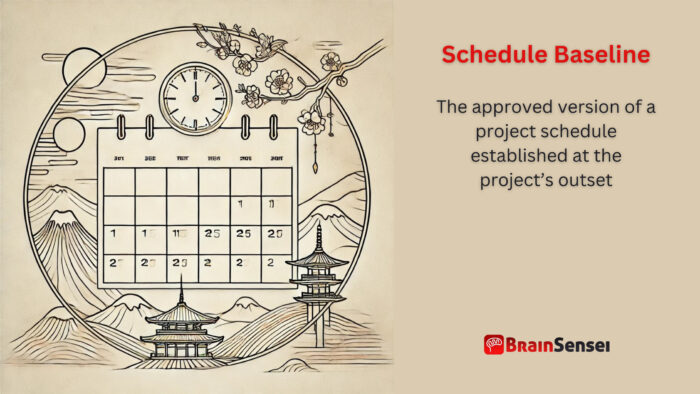
Schedule Baseline
What is a Schedule Baseline?
A schedule baseline is the approved version of a project schedule established at the project’s outset. A project manager measures actual performance against this baseline, which includes key milestones, deliverables, and deadlines. The schedule baseline serves as a reference point for tracking progress. Any changes to the schedule baseline require formal approval through a change control process.
Key Takeaways
- The schedule baseline is a fixed reference for project timelines.
- It includes tasks, dependencies, milestones, and deadlines.
- Variance analysis helps track deviations from the baseline.
- Updates require formal change management approval.
- It enhances project control, forecasting, and stakeholder communication.
Understanding the Schedule Baseline
How It Works
A project scheduling tool develops the schedule baseline, incorporating task durations, dependencies, and constraints. It is derived from the project scope and resource availability, ensuring alignment with organizational goals. Once approved, the schedule baseline becomes the standard for measuring performance. If deviations occur, project managers analyze the causes and take corrective actions or request approved schedule changes.
Important Considerations
- The baseline freezes the plan but does not prevent changes when necessary.
- Variance analysis identifies schedule slippage or acceleration.
- Baselines differ from schedules—a schedule can change, but the baseline is static until formally updated.
- Aligns with cost and scope baselines to maintain project control.
Related Terms
- Project Baseline: A combination of scope, schedule, and cost baselines used to measure project performance
- Performance Measurement Baseline (PMB): A tool that combines scope, schedule, and cost targets to measure and evaluate project performance and progress
- Schedule Variance (SV): A measure of deviation from the planned schedule, calculated as Earned Value (EV) minus Planned Value (PV)
- Critical Path Method (CPM): A project management technique that identifies the longest sequence of dependent tasks to ensure timely project completion
- Change Control Process: A formal procedure for evaluating and approving modifications to project baselines
- Earned Value Management (EVM): A methodology that integrates scope, schedule, and cost to assess project performance
Examples of Schedule Baseline in Industries
Construction Industry – High-Rise Commercial Building Project
A construction company develops a 50-story commercial skyscraper in a metropolitan area. The schedule baseline includes key phases: site preparation, foundation work, structural framing, exterior cladding, mechanical and electrical systems, interior finishing, and final inspections. Each phase has strict deadlines to ensure project completion within four years.
After 18 months, the project manager notices a two-month delay due to unexpected geological conditions affecting the foundation work. A variance analysis reveals that soil stability issues require additional reinforcement, which was not part of the initial risk assessment. The project team evaluates options to mitigate the delay, such as overlapping certain construction activities (fast-tracking) and increasing workforce shifts. Despite these efforts, the delay impacts later milestones.
The project manager initiates a schedule baseline revision through the change control process to maintain transparency. The revised baseline incorporates the new foundation timeline while ensuring no further cascading delays. This adjustment helps prevent legal disputes and contractual penalties while maintaining stakeholder confidence in the project’s completion plan.
IT & Software Development – E-commerce Platform Launch
A leading e-commerce company plans to launch a new online marketplace with an integrated AI-based recommendation engine. The schedule baseline includes requirements gathering, UI/UX design, frontend and backend development, database integration, testing, and deployment. The total project duration is 14 months, with a fixed deadline to align with a major shopping event.
Six months into the project, the development team encountered unexpected API integration issues with third-party payment gateways, causing backend development bottlenecks. As a result, testing was delayed by three weeks, pushing back subsequent activities. The project manager assessed the schedule variance and conducted a risk impact analysis. Since missing the launch deadline could result in millions of dollars in lost revenue, leadership allocated additional developers and automated parts of the testing phase to recover lost time.
The schedule baseline remains unchanged, but corrective actions help realign the project to its original timeline. By continuously monitoring progress and making data-driven decisions, the company successfully launches the platform on schedule, avoiding reputational damage and maximizing sales potential.
Government Infrastructure Projects – Highway Expansion
A government agency responsible for national infrastructure is beginning a highway expansion project to alleviate congestion in a major urban corridor. The schedule baseline includes land acquisition, environmental assessments, road design, procurement of materials, construction phases, and quality assurance checks. The project is expected to last seven years and involves phased openings for different sections of the highway.
Two years into the project, unexpected delays occurred due to environmental concerns raised by regulatory authorities. New assessments require modifications to the original design to minimize ecological impact. These additional studies extend the land acquisition phase by nine months, impacting procurement and construction schedules. The project management team conducts a schedule impact analysis and determines that postponing certain activities would be costly and disruptive. They propose a revised sequencing plan that allows the team to begin preliminary construction work in unaffected areas while completing environmental modifications.
Due to the project’s scale and funding complexity, the project team has submitted a formal schedule baseline revision for approval. This update aligns with revised environmental regulations while informing stakeholders about the adjusted timeline. The new schedule ensures that sections of the highway are still delivered in phases, avoiding the project’s complete stagnation.
Aerospace & Defense – Military Aircraft Development
The Air Force has awarded a defence contractor a contract to develop a next-generation fighter jet. The schedule baseline outlines a timeline for research, prototype design, wind tunnel testing, structural fabrication, avionics integration, flight testing, and production. Given its complexity, the project follows a 10-year development cycle.
Five years into the program, avionics integration faces severe challenges due to rapid technological advancements. The original schedule baseline did not anticipate significant breakthroughs in AI-powered flight control systems, which now require a redesign to remain competitive. This issue causes an 18-month delay in flight testing. The project team conducts a trade-off analysis, weighing the risks of delaying production against the benefits of incorporating cutting-edge technology.
Since national security is at stake, stakeholders decide to update the schedule baseline rather than compromise on quality. The revised plan incorporates the new avionics system but requires additional funding and resource allocation. This decision ensures the aircraft remains at the forefront of defence technology while managing risks associated with extended timelines.
Healthcare & Pharmaceuticals – COVID-19 Vaccine Development
A global pharmaceutical company sets an aggressive schedule baseline to develop a COVID-19 vaccine in record time. The plan includes preclinical research, human trials (Phases I, II, and III), regulatory approvals, manufacturing, and distribution. Vaccine development usually takes 5–10 years, but the pandemic has set the target at 12–18 months.
Midway through the trials, unexpected side effects in certain demographics led to temporary trial suspension, causing a two-month delay. The project management team conducted a scheduled risk assessment and explored ways to recover time without compromising safety. The team decided to perform parallel regulatory reviews rather than waiting for sequential approvals. This approach, known as rolling submissions, helps regain lost time.
Despite the temporary delay, the original schedule baseline remains unchanged, as the strategic adjustments allow the project to stay on track. By closely monitoring progress and adapting to evolving challenges, the company successfully brings the vaccine to market within the projected timeline, saving millions of lives.
Key Takeaways from Industry Examples
- Schedule baseline deviations are common, but project teams can mitigate them through proactive monitoring.
- Not all delays require baseline changes—corrective actions like fast-tracking or resource reallocation can help maintain the original schedule.
- Formal schedule baseline revisions are necessary when significant scope changes or unforeseen risks impact project viability.
- Effective stakeholder communication is crucial to maintain confidence and project credibility when modifying baselines.
- Technology and innovation can impact project timelines, requiring flexibility in managing schedule baselines in fast-evolving industries.
These examples highlight the importance of strategic schedule baseline management across industries. Project managers can navigate challenges by implementing best practices while ensuring successful project delivery.
Use Cases of Schedule Baseline
Canada (Renewable Energy Project)
A Canadian energy company is embarking on a large-scale wind farm installation to support the nation’s transition to renewable energy. The schedule baseline is set for three years and covers site selection, environmental impact studies, procurement, construction, and grid integration. The project’s success hinges on meeting key deadlines to qualify for government incentives and ensure a return on investment.
Six months into the project, severe winter storms delayed foundation work for the wind turbines, causing a four-month setback and threatening milestone commitments. The project team conducted a variance analysis and identified critical dependencies that they could adjust. To mitigate further delays, they implemented parallel task execution, allowing electrical infrastructure work to proceed while waiting for improved weather conditions.
Despite these efforts, supply chain disruptions further impact turbine deliveries. The project management team engages in proactive stakeholder communication and negotiates alternative supplier contracts. After reassessing the risk matrix, they adjust the schedule baseline to reflect the new procurement timeline. The project remains on track to deliver clean energy by maintaining agility, leveraging contingency plans, and minimizing cost overruns.
Germany (Automotive Industry)
A German automaker launches an ambitious project to develop a new electric vehicle (EV) prototype with cutting-edge battery technology. The schedule baseline allocates four years for concept development, engineering, safety testing, regulatory approval, and production ramp-up. The company must adhere to strict deadlines to maintain a competitive edge while navigating evolving government regulations on emissions and battery safety.
Midway through the second year, unexpected battery performance issues arise during testing, causing a six-month delay in validation trials. Since this directly affects the production timeline, the project manager initiates a scheduled risk assessment to evaluate possible countermeasures. The team overlaps design refinement with supplier negotiations, ensuring no additional time is lost.
As the project advances, changes in EU regulatory standards require additional safety testing. The project team proactively revises the schedule baseline, incorporating extended testing phases while identifying cost-effective measures to prevent further delays. The automaker successfully navigates these obstacles by leveraging real-time data and advanced simulation software, launching the EV within the revised timeframe.
Singapore (Smart City Initiative)
A Singapore-based urban development agency initiated a smart city project to integrate AI-driven traffic management, IoT-enabled public utilities, and automated security systems. The project team has set a five-year schedule baseline and will phase the implementation to ensure seamless integration with existing infrastructure.
Two years into the project, a combination of public resistance to surveillance technologies and cybersecurity concerns led to unexpected regulatory scrutiny. The project managers assessed stakeholder impact, identifying opportunities for enhanced public engagement and compliance strategies. They allocated additional resources to public awareness campaigns to avoid derailing the timeline and incorporated privacy-by-design principles into system architecture.
Additionally, the emergence of 5G technology presents an opportunity to improve project efficiency. The team submitted a baseline adjustment request, integrating 5G-based automation earlier than planned. This strategic pivot mitigates the delays caused by regulatory challenges and enhances the city’s long-term digital infrastructure.
Key Takeaways from Use Cases
- Proactive risk management helps prevent schedule baseline deviations from escalating into full-scale project failures.
- Stakeholder communication and regulatory alignment are critical for maintaining project momentum, particularly in highly regulated industries.
- Agility and adaptability in baseline adjustments enable organizations to capitalize on emerging technologies and unforeseen opportunities.
- Parallel task execution and contingency planning minimize the impact of delays and ensure continuous progress.
- Data-driven decision-making and simulation modelling enhance predictive scheduling, improving project resilience in dynamic environments.
These real-world applications highlight the strategic value of schedule baselines in ensuring successful project execution across different sectors and regions.
Best Practices for Managing a Schedule Baseline
Successfully managing a schedule baseline requires strategic planning, continuous monitoring, and adaptability. Below are key best practices that ensure schedule baselines remain effective throughout the project lifecycle:
Establishing a Realistic and Detailed Schedule Baseline
A schedule baseline should be comprehensive and achievable, considering potential risks, dependencies, and resource constraints. Project managers must collaborate with stakeholders to ensure accurate time estimates and feasible deadlines.
- Use historical project data to improve schedule accuracy.
- Account for potential risks and include contingency buffers.
- Ensure task dependencies are clearly defined.
Continuous Monitoring and Performance Tracking
Regular progress tracking against the schedule baseline helps identify deviations early and implement corrective actions before issues escalate.
- Utilize project management tools like Microsoft Project or Primavera P6.
- Conduct variance analysis to assess schedule slippage.
- Establish Key Performance Indicators (KPIs) for milestone tracking.
Implementing a Robust Change Control Process
Schedule baselines should be formally updated only through a structured change control process when necessary. Any modifications must be justified, documented, and approved.
- Define clear criteria for approving schedule changes.
- Ensure all stakeholders are informed and aligned.
- Maintain version control of updated schedule baselines.
Risk Mitigation and Contingency Planning
Unexpected challenges can impact project timelines. A proactive risk management approach helps minimize disruptions.
- Identify high-risk areas early and develop mitigation strategies.
- Allocate resources flexibly to handle unforeseen circumstances.
- Conduct scenario planning for worst-case and best-case situations.
Effective Stakeholder Communication
Transparent communication ensures that all project stakeholders remain aligned with schedule expectations and changes.
- Hold regular status meetings to review the progress of the schedule.
- Utilize dashboards and reports to provide real-time updates.
- Address stakeholder concerns proactively to avoid misunderstandings.
Leveraging Technology and Automation
Advanced project management software and automation tools improve accuracy, efficiency, and visibility in schedule baseline management.
- Use AI-driven analytics to predict potential delays.
- Implement automated alerts for milestone tracking.
- Leverage cloud-based collaboration tools for remote team coordination.
Conclusion: A well-managed schedule baseline is a critical foundation for project success. Project managers can ensure projects stay on track by establishing realistic timelines, monitoring performance, implementing a structured change process, and leveraging technology. These best practices enhance efficiency, enable organizations to adapt to uncertainties, and drive successful project outcomes.
Schedule Baseline: Common Mistakes and Issues
Managing a schedule baseline requires attention to detail and discipline. However, many organizations encounter common mistakes that lead to costly delays and inefficiencies. Below are the most frequent errors and how to avoid them:
Setting Unrealistic Timelines
One of the biggest mistakes in project scheduling is underestimating the time required for tasks and dependencies. When schedules are too aggressive, teams experience frequent delays, leading to missed milestones and budget overruns.
Solution: Base schedules on historical project data and industry benchmarks. Involve subject matter experts in estimating realistic task durations.
Ignoring Risk Management
Failing to integrate risk assessment into schedule planning can lead to unforeseen disruptions. Projects often encounter delays due to regulatory changes, supply chain disruptions, or technical failures.
Solution: Conduct a comprehensive risk analysis and develop mitigation plans for high-risk activities. Use scenario planning to prepare for potential disruptions.
Poor Stakeholder Communication
Misalignment between project teams and stakeholders can result in confusion, mismanaged expectations, and scope creep. Stakeholders may not be aware of schedule adjustments, leading to conflicts.
Solution: Establish clear communication protocols and provide regular updates through status reports and meetings. Use dashboards to enhance transparency.
Inadequate Change Control Processes
Uncontrolled project scope and task modifications can significantly deviate from the original schedule baseline. Without a structured change control process, projects become chaotic and prone to failure.
Solution: Implement a formal change management process requiring approval for baseline adjustments. Document all changes and assess their impact on timelines.
Lack of Schedule Monitoring and Adjustments
A static schedule that the team doesn’t review frequently can lead to unnoticed deviations. Some teams fail to monitor progress, only realizing delays when they become critical.
Solution: Conduct weekly variance analyses to compare actual progress against the schedule baseline. Proactively adjust work plans to address potential slippages.
Overlooking Resource Availability
Another common mistake is assuming that resources will always be available as planned. Unexpected staff shortages, equipment failures, or supplier delays can throw schedules off track.
Solution: Use resource levelling techniques to ensure efficient allocation. Identify alternative resource options to mitigate potential shortages.
Rigid Scheduling Approaches
Some project teams adhere too strictly to the original schedule, even when it becomes evident that changes are needed. A lack of flexibility can hinder project success.
Solution: Adopt agile scheduling methodologies, allowing adjustments when justified. Build in buffer time to accommodate uncertainties.
Conclusion: Avoiding these common mistakes in schedule baseline management can significantly improve project outcomes. By setting realistic timelines, integrating risk management, maintaining effective communication, enforcing change control processes, and leveraging adaptive scheduling strategies, organizations can ensure that their projects remain on track and within budget. A well-maintained schedule baseline is essential for successful project execution and long-term business success.
Schedule Baseline Frequently Asked Questions (FAQs)
How does a schedule baseline differ from a project schedule?
A schedule baseline is the approved schedule version used for performance tracking. However, a project schedule is dynamic and may change over time due to unforeseen factors.
What happens if a project deviates from the schedule baseline?
Deviations trigger variance analysis to assess their impact. If necessary, the team implements corrective actions or formal baseline revisions through a change control process.
How do project managers ensure adherence to the schedule baseline?
Project managers use tracking tools, performance reports, and risk mitigation strategies to ensure the project stays aligned with the schedule baseline.
Can a schedule baseline be changed?
Yes, but only through a formal change control process that requires stakeholder approval.
How does a schedule baseline affect project success?
A well-maintained schedule baseline ensures timely delivery, cost control, and stakeholder alignment, reducing risks of project failure.
Additional Resources
- Comprehensive Guide to Project Management Schedule and Cost Control, A: Methods and Models for Managing the Project Lifecycle
- Tired Of Dealing With Project Schedule Delays? This Is How To Reduce And Prevent Them
Preparing for a PMI certification?
- Exam Prep Courses: PMP®, CAPM®, and PMI-ACP®
- Exam Simulators: PMP®, CAPM®, PMI-ACP®, PMI-PBA®, PMI-RMP®, PMI-SP®, PgMP®, and PfMP®
- Professional Development Units (PDUs): 15, 30, and 60 PDU Bundles



